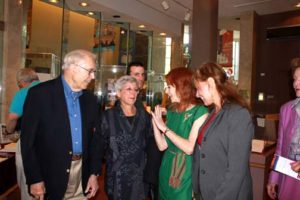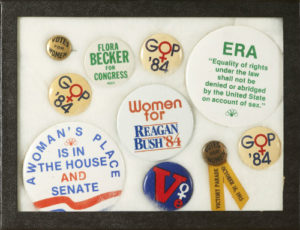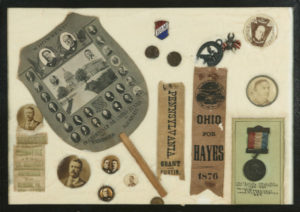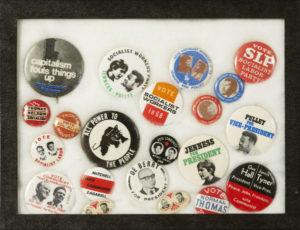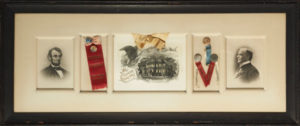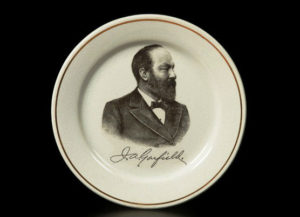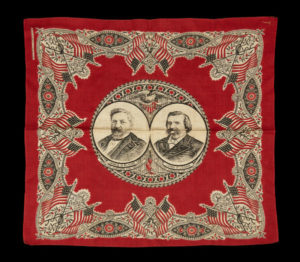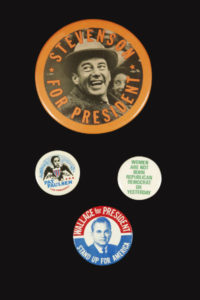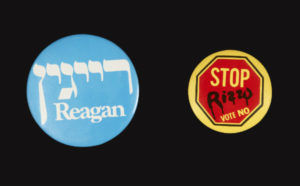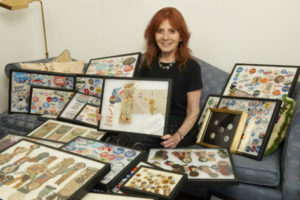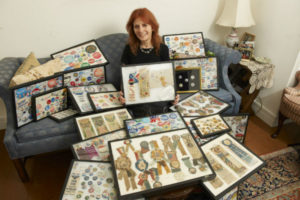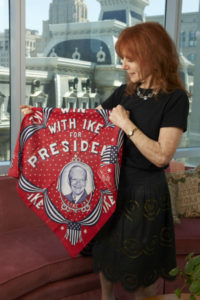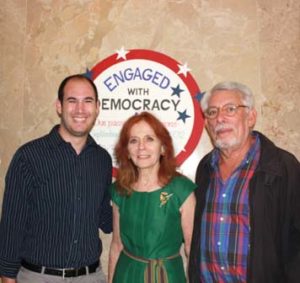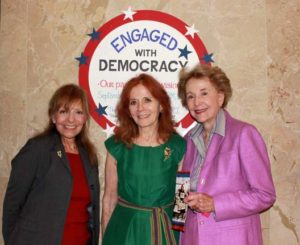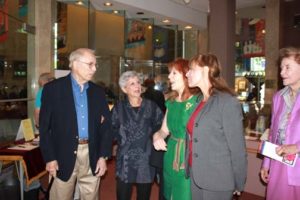-
Friday September 7th – Friday December 21st, 2012
Engaged with Democracy - Our Passions, Our Visions
* The Political Memorabilia Collection of Flora and Edward Becker
* Contemporary Art Work
* Art and Ephemera from the Collection of the Temple Judea Museum
From the Curator’s Statement: To understand the link between Jewish thought and the democratic process one has only to look at Philadelphia’s historic Liberty Bell, commissioned in 1751 to celebrate fifty years of William Penn’s Charter of Privileges, the colony’s law until 1776. The inscription chosen for the bell by a committee of the Pennsylvania Provincial Assembly is, “Proclaim liberty throughout all the land unto all the inhabitants thereof.” from the book of Leviticus 25:10.
So we have chosen to look at political life, specifically the campaign process, through the lens of a biblically established Jewish affinity to be involved in processes that shape our governance.
This exhibition demonstrates that political campaigns are really about citizens who care passionately about the democratic process. This visual narrative tells stories of ardent collectors and artists who make the intangibles of doctrines and partisanship a tangible, accessible reality.
Rita Rosen Poley, Curator/Director
Rabbi’s Statement:
Stand Beside Her and Guide Her: Jews, Politics and America
Jewish people have lived in every imaginable polity from clans to tribes; from limited monarchies to empires; from dictatorships of all stripes to democracies. Jews have also supported a wide spectrum of political ideologies and economic philosophies. Jewish people have lived as an autonomous nation, as resident aliens and as enfranchised citizens of non-Jewish states. Today, the largest Jewish community in the world is in the State of Israel and is self-governing. The world’s second largest Jewish community is to be found here in the United States where Jews are a fully enfranchised ethno-religious minority in a remarkably heterogeneous society.
American Jews have been particularly passionate about their involvement in American politics from the arrival of Jews in the Dutch Colony of New Amsterdam in 1654 until today. Touchstones of this involvement include: the first Jewish colonists sustained effort for permission to settle permanently in New Amsterdam; the election of the first Jew to political office in the United States in 1776 (in South Carolina); the first Jew appointed to the Supreme Court; the first Jew to run for Vice President of the United States. Jews have been among the most politically active groups in American history. Jews have been Jeffersonians, Democrats, Republicans, Socialists, Libertarians, Bull Moose Progressives and more. Jews vote in record numbers, work for political campaigns and donate generously to political campaigns at every level of government. Jews even lobby the government of the United States. AIPAC, the pro-Israel lobby, is the leading, but hardly unique, example of American Jewish activism.
Reform Judaism, as a religious movement, has also been politically active for over a hundred years. KI’s own Rabbi David Einhorn was a famous abolitionist. Beginning in the Progressive Era, Reform leaders, both lay and rabbinic, took controversial stands on child labor; separation of church and state; immigration policy; war and peace. The legislation for the Civil Rights Act of 1964 was actually written on the premises of the Reform movement’s Religious Action Center (RAC) in the nation’s capital. The RAC continues to be an integral part of the “Inside the Beltway” scene in Washington to this day.
Thus, it is not surprising that collecting political memorabilia is a hobby among American Jews. Years ago, I remember being awed by the collection of our late congregational President, Horace Stern. Now, I am equally amazed by the political collection of Flora Becker and her late husband, the Hon. Ed Becker, z”l. It is a privilege, honor and joy to have the Becker Collection exhibited at KI. As you look at each and every item, try to recall your own ‘elections past’ and where you stood politically, the debates you had and the ballots you cast.
Politics is not a sport for the fainted hearted. It can be brutal and bruising. But is also an inalienable right for us to participate in the political process as individuals and as members of a small sub-community who proudly call themselves Americans. I was too young to say whether or not “I liked Ike” but I love “I like Ike” buttons, Gene McCarthy buttons and President McKinley buttons. They all point to the same things: our shared democratic values; our belief in the equality of all people in the eyes of the law; and the ongoing, inspiring promise of America!
Shana Tova and enjoy this opportunity to “Engage with Democracy”!
Rabbi Lance J. Sussman, Ph.D.
SELECTED IMAGE LIST FROM THE EXHIBITION:
- Image: DSC2276 Women’s Board
The pins on this board span a range of the history of women in politics from the 1915 campaign to secure women’s suffrage to later attempts by male candidates to influence the growing demographic of female voters, to pins for women running for office on their own and for the ratification of the Equal Rights Amendment.
PIN: Women’s Vote: Victory Parade – October 16, 1915
On October 16, 1915, supporters of women’s suffrage in Massachusetts held a rally and parade, involving some 15,000 marchers and 30 bands, in support of an unsuccessful ballot measure that would have amended the Massachusetts Constitution to grant women the right to vote. Boston was not entirely sympathetic to the cause. According to the Boston Globe, on the day of the parade, “antis” (those opposed to women’s suffrage) prepared over 100,000 red “blushing” roses for protestors to wear in silent testimony to their opposition to women’s suffrage. Massachusetts was one of four states to hold a vote on the issue of female suffrage that year; similar measures in New Jersey, New York, and Pennsylvania were also defeated.
- Image: DSC2318 – Garfield Plate
Made for the 1880 presidential campaign this plate features a portrait of Republican candidate J. A. Garfield with a facsimile signature.
President Garfield served only 200 days in office before being assassinated. The reverse of the plate bears the British Royal Arms and “Warranted / Iron Stone China / Etruria Pottery Co.” maker’s mark of the Ott & Brewer Company.
- Image: DSC2280 Lincoln Ribbon
This commemorative silk Lincoln Ribbon, 1892, was made by the Phoenix Silk Manufacturing Company in New Jersey. It contains a quote from the Emancipation Proclamation at the bottom. H-14.5 W-2.625 inches
Quote: With malice toward none, with charity for all, with firmness in the right as God gives us to see the right, let us finish the work we are in, to bind up the nation’s wounds, to care for him who shall have borne the battle, and for his widow and his orphans; to do all which may achieve and cherish a just and lasting peace among ourselves and with all nations.”
4. Image: DSC2335: Logan/Blaine Handkerchief
An 1884 campaign handkerchief for the election of James G. Blaine and John A. Logan. Blaine, former U.S. Senator and Speaker of the House, and Senator John A. Logan of Illinois ran unsuccessfully on the Republican ticket for president and vice president against Democrats Grover Cleveland and Thomas A. Hendricks. The 1884 election marked the first time a woman ran for office, with Belva Ann Lockwood running as the candidate for the Equal Rights Party.
PRINTED HANDKERCHIEFS became popular in Britain during the mid-seventeenth century. Printed in part to hide snuff stains, designs included city maps and London cab fees as well as notable figures and commemorative events. residential depictions on handkerchiefs appeared very early in our country’s history. A depiction of George Washington on horseback, commissioned by his wife, Martha, and printed by a colonial printer, John Hewson, dates to 1776.
- Image: DSC2311 – Union League
Commemorative memorabilia of the Founders’ Day celebration at the Philadelphia Union League (UL) on November 24, 1900. The campaign buttons and ribbon indicate the UL support for the election of William McKinley and Theodore Roosevelt. Mounted on the back of the frame is the banquet menu served that evening and attended by McKinley. Roosevelt also was in attendance and gave a speech (text available – From Almanac of Theodore Roosevelt website)
“Founders’ Day was observed on Saturday evening, November 24, 1900, by a banquet, which, in elaborate detail and feature, surpassed any previous function in the history of the Union League. The Union League has had the honor of entertaining most of the eminent men of our country, whose personality and deeds have left an enduring impress upon the national life, but it remained for Founders’ Day, 1900, to bring together the most remarkable company of distinguished public men ever assembled at one time within its walls.” Chronicle of the Union League of Philadelphia 1862 to 1902
- Image DSC2304 – Early elections:
TOP LEFT: A decorative fan produced for the 1908 Presidential race between Taft and Bryan. Next to Taft is an eagle and next to Bryan is a rooster. The eagle represents the Republican Party (most commonly in NY state) and the rooster represents the Democratic Party. The donkey is known as the Democratic Party symbol but in 1840 in Indiana the rooster was adopted as the Democratic Party symbol. Even today different symbols are used in different states.
CENTER TOP: A 23mm x 32mm red, white, and blue enameled badge from 1888 Harrison/ Morton campaign
THE GARFIELD COIN IS NEAR THE TOP. IT IS THE PIN ON THE RIGHT OF THE TWO AT THE CENTER TOP.
Commemorative medallion: “James Garfield – Canal boy 1845 – President 1881″
Front: Portrait of Garfield. Reverse: The White House and a boy on horseback pulling a boat on the Erie Canal. The last president born in a log cabin, as a child Garfield dreamed of a seafaring life, but instead worked for a time pulling flatboats on the Ohio Canal.
TOP RIGHT: Philander C Knox (1883 – 1921) Republican for President, 1908. The Pin used to have a red, white and blue ribbon attached. You can barely see the remnants attached to the right hand side.
- Image: DSC2306 – Socialist and Communist (Hall – Pulley – De Berry)
NO INFORMATION
- Image DSC2338 – Presidential Losers and the Women’s Struggle for Electoral Parity:
“Stevenson”, “Wallace”, ”Paulsen”, “Women are not born Democrat, Republican or Yesterday”
Adlai Stevenson ran twice against Eisenhower and lost both times. In his third attempt he even lost his party’s nomination to Kennedy. Comedian Pat Paulsen ran in six elections from 1968 to 1996 and lost all of them. George Wallace attempted to win the presidency and failed four times, and was coined “The most influential Loser” in 20th century U.S. politics by his biographers. Throughout most of his political career he preached the continuation of segregation and its benefits. In the late 1970s He changed his views as a “born again” Christian and apologized to black civil rights leaders.
The pin about women is unexplained.
- Image DSC2343 – Regan in Hebrew; Stop RIZZO
These two pins, Reagan (1980) in Hebrew and Stop Rizzo, represent the power of minority voting populations. Reagan targeted a demographic that could help him win an election, working hard to win the Jewish vote. The “Stop Rizzo” pin (1983) shows how a dissatisfied demographic, African Americans in Philadelphia, worked together and blocked Rizzo from being able to run for a third consecutive term. Reagan won by targeting a specific group. Rizzo lost to an African American, the voting group he seemed to anger.

